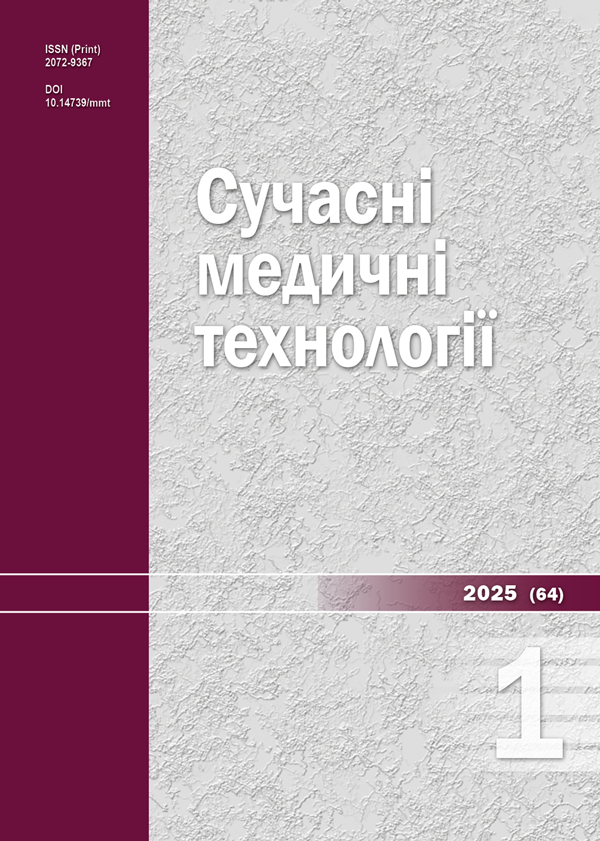The importance of using mobile ultrasound devices in improving the quality and safety of emergency care, anesthesia and intensive care
DOI:
https://doi.org/10.14739/mmt.2025.1.318152Keywords:
ultrasonography, anesthesiology, analgesia, intensive care, invasive manipulations, emergency conditionsAbstract
The aim of this review is to determine the role of ultrasound visualization in improving the safety and quality of anesthesia, intensive care and emergency medical care.
The article explores the role of ultrasound imaging in improving the quality and safety of diagnostics, analgesia, and intensive care, particularly in emergency conditions. The authors emphasize the importance of using portable ultrasound devices that enhance diagnostic accuracy and enable bedside or prehospital procedures. The study highlights the significance of ultrasound protocols, such as POCUS, FAST, eFAST, LUCI, and others which standardize diagnostics and invasive interventions. These protocols have proven to be effective in diagnosing shock states, pneumothorax, internal organ injuries, and critical complications. Ultrasound is also widely used to improve the safety of invasive procedures like central venous catheterization, regional nerve blocks, and epidural anesthesia. In children, ultrasound helps to reduce the number of complications during procedures due to its high accuracy of visualization. The authors point out that ultrasound is an important tool for monitoring the condition of patients with respiratory and heart failure, allowing for the prompt detection of pathological changes in the lungs and heart. In addition, the use of ultrasound examination significantly reduces the radiation exposure compared to X-rays and computerized tomography scans.
Despite significant progress, there are limitations related to the anatomical features of patients, the difficulty of finding acoustic windows, and the need for specialized training of doctors. Future developments include further standardization of protocols, improvement of ultrasound device capabilities, and the creation of international training programs.
Conclusions. Ultrasound visualization improves the quality of diagnosis, anesthesia and intensive care, significantly increases the accuracy and safety of invasive procedures. Using ultrasonic visualization methods can be problematic in cases where it is difficult to find an acoustic window. Further expansion of the use of the POCUS concept and integration of ultrasound into life support algorithms are related to the development of available compact, highly sensitive ultrasound devices suitable for prehospital diagnostics.
References
Kendall JL, Hoffenberg SR, Smith RS. History of emergency and critical care ultrasound: The evolution of a new imaging paradigm. Crit Care Med. 2007;35(Suppl):S126-S130. doi: https://doi.org/10.1097/01.ccm.0000260623.38982
Schmidt S, Dieks J-K, Quintel M, Moerer O. Clinical decision-making in practice with new critical care ultrasound methods for assessing respiratory function and haemodynamics in critically ill patients. Clin Pract. 2022;12(6):986-1000. doi: https://doi.org/10.3390/clinpract12060102
Lau YH, See KC. Point-of-care ultrasound for critically ill patients: A mini-review of key diagnostic features and protocols. World J Crit Care Med. 2022;11(2):70-84. doi: https://doi.org/10.5492/wjccm.v11.i2.70
Jensen MB, Sloth E, Larsen KM, Schmidt MB. Transthoracic echocardiography for cardiopulmonary monitoring in intensive care. Eur J Anaesthesiol. 2004;21(9):700-7. doi: https://doi.org/10.1017/s0265021504009068
Spencer KT, Kimura BJ, Korcarz CE, Pellikka PA, Rahko PS, Siegel RJ. Focused cardiac ultrasound: Recommendations from the American Society of Echocardiography. J Am Soc Echocardiogr. 2013;26(6):567-81. doi: https://doi.org/10.1016/j.echo.2013.04.001
Neskovic AN, Skinner H, Price S, Via G, De Hert S, Stankovic I, et al. Focused cardiac ultrasound core curriculum and core syllabus of the European Association of Cardiovascular Imaging. Eur Heart J Cardiovasc Imaging. 2018;19(5):475-81. doi: https://doi.org/10.1093/ehjci/jey006
Chin EJ, Chan CH, Mortazavi R, Anderson CL, Kahn CA, Summers S, et al. A pilot study examining the viability of a prehospital assessment with ultrasound for emergencies (PAUSE) protocol. J Emerg Med. 2013;44(1):142-9. doi: https://doi.org/10.1016/j.jemermed.2012.03.033
Seif D, Perera P, Mailhot T, Riley D, Mandavia D. Bedside ultrasound in resuscitation and the rapid ultrasound in shock protocol. Crit Care Res Pract. 2012;2012:503254. doi: https://doi.org/10.1155/2012/503254
Lau YH, Loh CH, Fong WK, Siddiqui S, Tan CK, Tan JJ, et al. Point-of-care ultrasound training among intensivists in Singapore: A multicentre survey. Ann Acad Med Singap. 2020;49(9):630-42. doi: https://doi.org/10.47102/annals-acadmedsg.2020108
Peris A, Tutino L, Zagli G, Batacchi S, Cianchi G, Spina R, et al. The use of point-of-care bedside lung ultrasound significantly reduces the number of radiographs and computed tomography scans in critically ill patients. Anesth Analg. 2010;111(3):687-92. doi: https://doi.org/10.1213/ANE.0b013e3181e7cc42
Bataille B, Riu B, Ferre F, Moussot PE, Mari A, Brunel E, et al. Integrated use of bedside lung ultrasound and echocardiography in acute respiratory failure: A prospective observational study in ICU. Chest. 2014;146(6):1586-93. doi: https://doi.org/10.1378/chest.14-0443
Long B, Alerhand S, Maliel K, Koyfman A. Echocardiography in cardiac arrest: An emergency medicine review. Am J Emerg Med. 2018;36(3):488-93. doi: https://doi.org/10.1016/j.ajem.2018.01.044
Kristensen MS, Teoh WH, Graumann O, Laursen CB. Ultrasonography for clinical decision-making and intervention in airway management: From the mouth to the lungs and pleurae. Insights Imaging. 2014;5(2):253-79. doi: https://doi.org/10.1007/s13244-014-0309-5
Hoyer HX, Vogl S, Schiemann U, Haug A, Stolpe E, Michalski T. Prehospital ultrasound in emergency medicine: Incidence, feasibility, indications and diagnoses. Eur J Emerg Med. 2010;17(5):254-9. doi: https://doi.org/10.1097/MEJ.0b013e328336ae9e
Yoshida T, Yoshida T, Noma H, Nomura T, Suzuki A, Mihara T. Diagnostic accuracy of point-of-care ultrasound for shock: A systematic review and meta-analysis. Crit Care. 2023;27(1):200. doi: https://doi.org/10.1186/s13054-023-04495-6
Na MJ. Diagnostic tools of pleural effusion. Tuberc Respir Dis. 2014;76(5):199-210. doi: https://doi.org/10.4046/trd.2014.76.5.199
Scarlata S, Venditti I, Fulco G, Finamore P, Giua R, Antonelli Incalzi R, et al. Estimation of pleural effusion volume through chest ultrasound: Validation of two multiplanar models. Ultrasound Med Biol. 2020;46(8):1960-7. doi: https://doi.org/10.1016/j.ultrasmedbio.2020.04.020
Mongodi S, Via G, Girard M, Rouquette I, Misset B, Braschi A, et al. Lung ultrasound for early diagnosis of ventilator-associated pneumonia. Chest. 2016;149(4):969-80. doi: https://doi.org/10.1016/j.chest.2015.12.012
Mongodi S, De Vita N, Salve G, Bonaiti S, Daverio F, Cavagnino M, et al. The role of lung ultrasound monitoring in early detection of ventilator-associated pneumonia in COVID-19 patients: A retrospective observational study. J Clin Med. 2022;11(11):3001. doi: https://doi.org/10.3390/jcm11113001
Pradhan S, Shrestha PS, Shrastha GS, Marhatta MN. Clinical impact of lung ultrasound monitoring for diagnosis of ventilator-associated pneumonia: A diagnostic randomized controlled trial. J Crit Care. 2020;58:65-71. doi: https://doi.org/10.1016/j.jcrc.2020.04.008
Millot G, Voisin B, Loiez C, Wallet F, Nseir S. Early detection of ventilator-associated pneumonia: Bedside tools. Egypt J Crit Care Med. 2020;7(22):74-9. doi: https://doi.org/10.1016/j.ejccm.2020.01.001
Rocca E, Zanza C, Longhitano Y, Piccolella F, Romenskaya T, Racca F, et al. Lung ultrasound in critical care and emergency medicine: Clinical review. Adv Respir Med. 2023;91(3):203-23. doi: https://doi.org/10.3390/arm91030017
Dinsmore M, Venkatraghavan L. Clinical applications of point-of-care ultrasound in brain injury: A narrative review. Anaesthesia. 2022;77 Suppl 1:69-77. doi: https://doi.org/10.1111/anae.15604
Newman WD, Hollman AS, Dutton GN, Carachi R. Measurement of optic nerve sheath diameter by ultrasound: A means of detecting acute raised intracranial pressure in hydrocephalus. Br J Ophthalmol. 2002;86(10):1109-13. doi: https://doi.org/10.1136/bjo.86.10.1109
Gauthey M, Tessaro MO, Breitbart S, Kulkarni AV, Davis AL. Reliability and feasibility of optic nerve point-of-care ultrasound in pediatric patients with ventricular shunts. Childs Nerv Syst. 2022;38(7):1289-95. doi: https://doi.org/10.1007/s00381-022-05532-x
Dubourg J, Javouhey E, Geeraerts T, Messerer M, Kassai B. Ultrasonography of optic nerve sheath diameter for detection of raised intracranial pressure: A systematic review and meta-analysis. Intensive Care Med. 2011;37(7):1059-68. doi: https://doi.org/10.1007/s00134-011-2224-2
Heldeweg ML, Vermue L, Kant M, Brouwer M, Girbes AR, Haaksma ME, et al. The impact of lung ultrasound on clinical-decision making across departments: A systematic review. Ultrasound J. 2014;14(1):5. doi: https://doi.org/10.1186/s13089-021-00253-3
Choi W, Cho YS, Ha YR, Oh JH, Lee H, Kang BS, et al. Role of point-of-care ultrasound in critical care and emergency medicine: Update and future perspective. Clin Exp Emerg Med. 2023;10(4):363-81. doi: https://doi.org/10.15441/ceem.23.101
Marbach JA, Almufleh A, Di Santo P, Jung R, Simard T, McInnes M, et al. Comparative accuracy of focused cardiac ultrasonography and clinical examination for left ventricular dysfunction and valvular heart disease: A systematic review and meta-analysis. Ann Intern Med. 2019;171(4):264-72. doi: https://doi.org/10.7326/M19-0070
Siadecki SD, Frasure SE, Lewiss RE, Saul T. High body mass index is strongly correlated with decreased image quality in focused bedside echocardiography. J Emerg Med. 2016;50(2):295-301. doi: https://doi.org/10.1016/j.jemermed.2015.08.006
Jiang L, Zhang F, Wei N, Lv J, Chen W, Dai Z. Could preprocedural ultrasound increase the first-pass success rate of neuraxial anesthesia in obstetrics? A systematic review and meta-analysis of randomized controlled trials. J Anesth. 2020;34(3):434-44. doi: https://doi.org/10.1007/s00540-020-02750-6
Yu D, Wang X, Jiang L, Wu Y, Han S, Li J. Evaluating the impact of ultrasound-guided subsheath versus extrasheath sciatic nerve block on postoperative wound pain in tibial and foot surgeries: A systematic review and meta-analysis. Int Wound J. 2024;21(4):e14640. doi: https://doi.org/10.1111/iwj.14640
Zhu M, Sun W. Application and research progress of ultrasound-guided brachial plexus block through costoclavicular space approach in upper limb surgery. Altern Ther Health Med. 2024;30(1):24-30. Available from: http://alternative-therapies.com/pdfarticles/9168.pdf
Attia JZ, Gaber RN, Mohamed SR. Ultrasound-guided retroclavicular approach versus costoclavicular approach of infraclavicular brachial plexus block for upper limb surgeries. Pain Physician. 2023;26(6):E651-E660. doi: http://dx.doi.org/10.36076/ppj.2023.26.E651
Jain D, Hussain SY, Ayub A. Comparative evaluation of landmark technique and ultrasound-guided caudal epidural injection in pediatric population: A systematic review and meta-analysis. Pediatr Anesth. 2022;32(1):35-42. doi: https://doi.org/10.1111/pan.14332
Chen J, Song D, Zheng G, Luo Y. Systematic review and meta-analysis of the effect of nerve block under ultrasound in ilioinguinal/iliohypogastric in children. Transl Pediatr. 2022;11(10):1604-14. doi: https://doi.org/10.21037/tp-22-308
Zawadka M, La Via L, Wong A, Olusanya O, Muscarà L, Continella C, et al. Real-time ultrasound guidance as compared with landmark technique for subclavian central venous cannulation: A systematic review and meta-analysis with trial sequential analysis. Crit Care Med. 2023;51(5):642-52. doi: https://doi.org/10.1097/CCM.0000000000005819
D'Arrigo S, Perna F, Annetta MG, Pittiruti M. Ultrasound-guided access to the axillary vein for implantation of cardiac implantable electronic devices: A systematic review and meta-analysis. J Vasc Access. 2023;24(4):854-63. doi: https://doi.org/10.1177/11297298211054621
Byon HJ, Lee GW, Lee JH, Park YH, Kim HS, Kim CS, et al. Comparison between ultrasound-guided supraclavicular and infraclavicular approaches for subclavian venous catheterization in children--a randomized trial. Br J Anaesth. 2013;111(5):788-92. doi: https://doi.org/10.1093/bja/aet202
Imbrìaco G, Monesi A, Spencer TR. Preventing radial arterial catheter failure in critical care: Factoring updated clinical strategies and techniques. Anaesth Crit Care Pain Med. 2022;41(4):101096. doi: https://doi.org/10.1016/j.accpm.2022.101096
Dhir A, Bhasin D, Bhasin-Chhabra B, Koratala A. Point-of-care ultrasound: A vital tool for anesthesiologists in the perioperative and critical care settings. Cureus. 2024;16(8):e66908. doi: https://doi.org/10.7759/cureus.66908
Osman A, Sum KM. Role of upper airway ultrasound in airway management. J Intensive Care. 2016;4:52. doi: https://doi.org/10.1186/s40560-016-0174-z
Sustić A, Miletić D, Protić A, Ivancić A, Cicvarić T. Can ultrasound be useful for predicting the size of a left double-lumen bronchial tube? Tracheal width as measured by ultrasonography versus computed tomography. J Clin Anesth. 2008;20(4):247-52. doi: https://doi.org/10.1016/j.jclinane.2007.11.002
Chacko J, Gagan B, Kumar U, Mundlapudi B. Real-time ultrasound-guided percutaneous dilatational tracheostomy with and without bronchoscopic control: An observational study. Minerva Anestesiol. 2015;81(2):166-74. doi: https://doi.org/10.1186/cc10047
Downloads
Additional Files
Published
How to Cite
Issue
Section
License
Copyright (c) 2025 Krishtafor A. A., Krishtafor D. A., Kravets O. V., Pylypenko O. V.

This work is licensed under a Creative Commons Attribution-NonCommercial 4.0 International License.
The work is provided under the terms of the Public Offer and of Creative Commons Attribution-NonCommercial 4.0 International (CC BY-NC 4.0). This license allows an unlimited number of persons to reproduce and share the Licensed Material in all media and formats. Any use of the Licensed Material shall contain an identification of its Creator(s) and must be for non-commercial purposes only.














